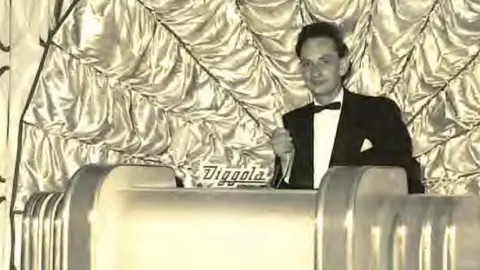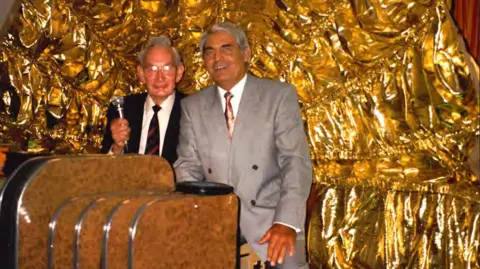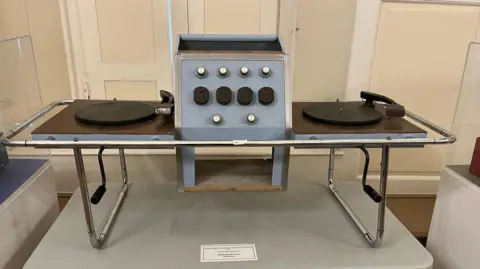'No Fatboy Slim' without small-town DJ pioneer
 Boston Borough Council
Boston Borough CouncilHe is described as the father of modern DJ music. Ron Diggins, from Boston, Lincolnshire, is credited with being the first person to use two record decks to blend seamlessly between tracks.
Now, a BBC Sounds documentary is shedding light on his life and an exhibition has celebrated his pioneering work.
It turns out that one of the earliest DJ decks was made out of wood intended for a very different purpose – coffins.
From a comfy armchair in a sunny conservatory in Market Rasen, Lincolnshire, 93-year-old Brian Golland smiles as he recalls his time working with Ron in the early 1950s.
It was a time when wood was still in short supply after the war, but "he knew an undertaker and managed to buy some", Golland says.
Diggins was working in secret on something he called a "Diggola".
The electric machine (the name was inspired by a kind of jukebox, The Rock 'n' Rolla) was able to play two records in quick succession, something industry experts say had not been done before.
"He pioneered the beginnings of DJ culture by twinning two decks together," says Carl Loben, the editor-in-chief of DJ Mag.
"He created a machine: a mobile disco deck. He could bring it into rooms and dance halls and play music.
"In essence it was the forerunner of DJ culture as we know it today."
"Without Ron, there may well have been no Fatboy Slim, no Calvin Harris and even possibly no international dance music culture whatsoever," Loben adds.
 Boston Borough Council
Boston Borough CouncilDiggins began playing records for parties and dances in the late 1940s, after a request from local women serving in the Land Army.
"He realised there was a gap in the market," says David Worthington, the curator of an exhibition about Diggins at the Guildhall Museum in Boston.
At the time, people who played records at dances would use a single turntable and typically talk over the process of switching from one record to another.
"Ron came up with this idea of cueing decks so that he could cue another record and then flick the deck down and the needle would go," Worthington says.
Golland describes the idea as "a brain wave".
The earliest DIY creations were rough and ready, with a frame made of two chairs welded together and a coffin-wood top, into which two manual gramophones were inserted.
"The handles were stuck out the side to wind them up," Brian remembers. "That was the very first machine I saw and heard."
Later machines were more advanced and used electric record players.
"The panel at the front changed colour: that was made from wood, an ordinary house lightbulb and some chicken wire," Golland says.
Keith Feary, another of Diggins' employees, recalls him pioneering other techniques now regularly used by modern DJs, including variable speed motors for the records, which allowed him to seamlessly blend tracks of different tempos.
"Some of these records were too fast for a dance," Feary says.
 BBC / Karl Bird
BBC / Karl BirdThe Diggola was an instant success and Diggins, along with his junior DJs Golland and Feary, appeared at hundreds of venues across the East Midlands.
"My pet saying was, 'they was swinging on the chandeliers'," Golland says with a laugh.
But not everyone was pleased with the birth of the mobile disco.
"We became very popular and of course the local bands didn't like it. We were robbing them of their income," Golland remembers.
Worthington says the musicians' union "decided that Ron was putting their members out of business".
The dispute led to an unconventional agreement being struck: Diggins would never play venues with more than 250 people in attendance.
He also agreed to note down the tracks he played in order to pay music rights.
Diggins' success continued into the 1960s and 70s, but his popularity eventually waned. "People wanted to be entertained by people their own age," as Golland puts it.
By the time Diggins approached retirement in 1994, aged 77, he had played at 23,500 dances in 800 venues, according to Feary.
'Man before his time'
Seventy-five years after Diggins began using his Diggola, an exhibition at the Guildhall Museum celebrated the life of the musical trailblazer.
Loben, whose DJ Mag champions today's DJ culture, says the now disgraced presenter Jimmy Savile laid claim to being the first two-deck DJ, but "I think was overinflating his own sense of self-importance".
"In terms of the general history of the time, Ron Diggins was more important because he actually made a deck, a portable machine."
Golland says Diggins was "a man before his time."
"He never looked for fame or fortune," he says. "He only charged £4 a night, of which he'd give £1.50 to me."
Even in the 1990s, Diggins never charged more than £50 for a gig.
The humble man, who died in 2007 aged 90, told reporters on his final birthday that he'd "invented nothing".
"I put the same things to a different use, that's all."
But to those in the know, he'll be remembered as a pioneer whose work helped launch a whole subculture of music.
Listen to highlights from Lincolnshire on BBC Sounds, watch the latest episode of Look North or tell us about a story you think we should be covering here.
